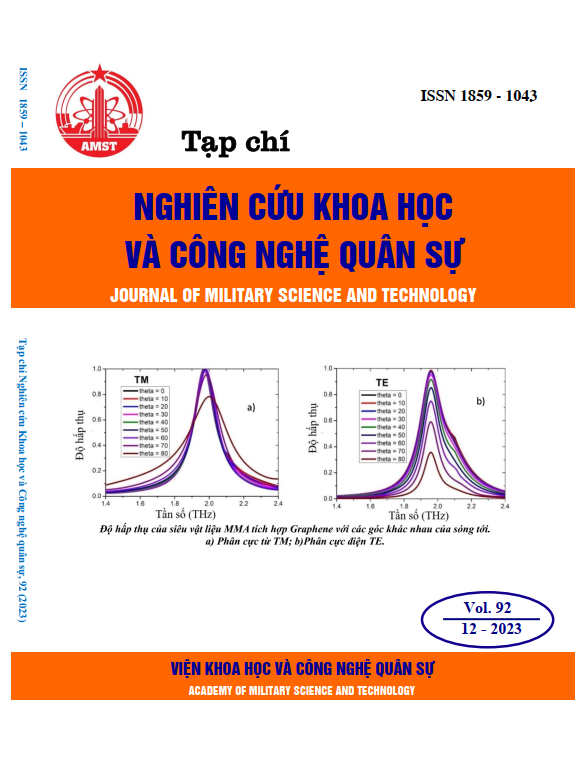Điều khiển thích nghi quadrotor với các tham số bất định
462 lượt xemDOI:
https://doi.org/10.54939/1859-1043.j.mst.92.2023.30-37Từ khóa:
Thiết bị bay; Quadrotor; Gradient tốc độ; Điều khiển thích nghi; Tham số bất định.Tóm tắt
Bài báo này trình bày kết quả tổng hợp luật điều khiển bám vị trí và ổn định cho thiết bị bay không người lái (UAV) dạng quadrotor, sử dụng thuật toán điều khiển thích nghi gradient tốc độ thích ứng với sự thay đổi bất định của các tham số. Kết quả mô phỏng bằng MATLAB/SIMULINK với mô hình quadrotor giả định chứng minh khi sử dụng bộ điều khiển thích nghi sẽ giúp quadrotor hoạt động một cách ổn định bám theo quỹ đạo bay trong trường hợp bất định các tham số của quadrotor.
Tài liệu tham khảo
[1]. R. Austin, “Unmanned aircraft systems: UAVS design, development and deployment vol. 54”: John Wiley & Sons, (2011). DOI: https://doi.org/10.1002/9780470664797
[2]. G. Hoffmann, D. G. Rajnarayan, S. L. Waslander, D. Dostal, J. S. Jang, and C. J. Tomlin, “The Stanford testbed of autonomous rotorcraft for multi agent control (STARMAC),” in Digital Avionics Systems Conference, 2004. DASC 04. The 23rd, pp. 12. E. 4-121, (2004).
[3]. J. P. How, B. BEHIHKE, A. Frank, D. Dale, and J. Vian, “Real-time indoor autonomous vehicle test environment,” IEEE control systems, vol. 28, pp. 51-64, (2008). DOI: https://doi.org/10.1109/MCS.2007.914691
[4]. F. Šolc, “Modelling and Control of a Quadrocopter,” Advanced in Military Technology, vol. 1, pp. 29-38, (2007).
[5]. M. Prabha, R. Thottungal, and S. Kaliappan, “Modeling and Simulation of X-Quadcopter Control,” International Journal for Research in Applied Science & Engineering Technology (IJRASET) [online] Available at: http://www. ijraset. com/fileserve. php, (2016).
[6]. A. Das, F. Lewis, and K. Subbarao, “Backstepping approach for controlling a quadrotor using lagrange form dynamics,” Journal of Intelligent and Robotic Systems, vol. 56, pp. 127-151, (2009). DOI: https://doi.org/10.1007/s10846-009-9331-0
[7]. Outeiro P., Carlos B. and Paulo J. “Multiple-model control architecture for a quadrotor with constant unknown mass and inertia.” Mechatronics 73, (2021). DOI: 10.1016/j.mechatronics.2020.102455. DOI: https://doi.org/10.1016/j.mechatronics.2020.102455
[8]. Trong-Toan Tran, Shuzhi Sam Ge & Wei He: “Adaptive Control of a Quadrotor Aerial Vehicle with Input Constraints and Uncertain Parameters”, International Journal of Control, (2017), DOI: 10.1080/00207179.2017.1309572 DOI: https://doi.org/10.1080/00207179.2017.1309572
[9]. Han Q, Liu X, Liu Z, Su H. “Adaptive Control for Quadrotors with Uncertain and Faulty Actuators”. Research Square; (2021). DOI: 10.21203/rs.3.rs-910922/v1 DOI: https://doi.org/10.21203/rs.3.rs-910922/v1
[10]. V T Tran, A M Korikov and D K Tran “Synthesis of an algorithm for automatic control of the quadcopter position using the control force estimation method” Journal of Physics: Conference Series, Volume 2291, The 17th International Conference on Electronic Devices and Control Systems, EDCS, (2021). DOI: https://doi.org/10.1088/1742-6596/2291/1/012017
[11]. Б. Р. Андриевский, А. Л. Фрадков, “Метод скоростного градиента и его приложения”, Автомат. и телемех., № 9, 3–72, (2021). DOI: https://doi.org/10.31857/S0005231021090014
[12]. Б. Р. Андриевский. “Нелинейные комбинированные системы управления движением”. Диссертация доктора технических наук. - Санкт-Петербург. - 232 с, (2004).







